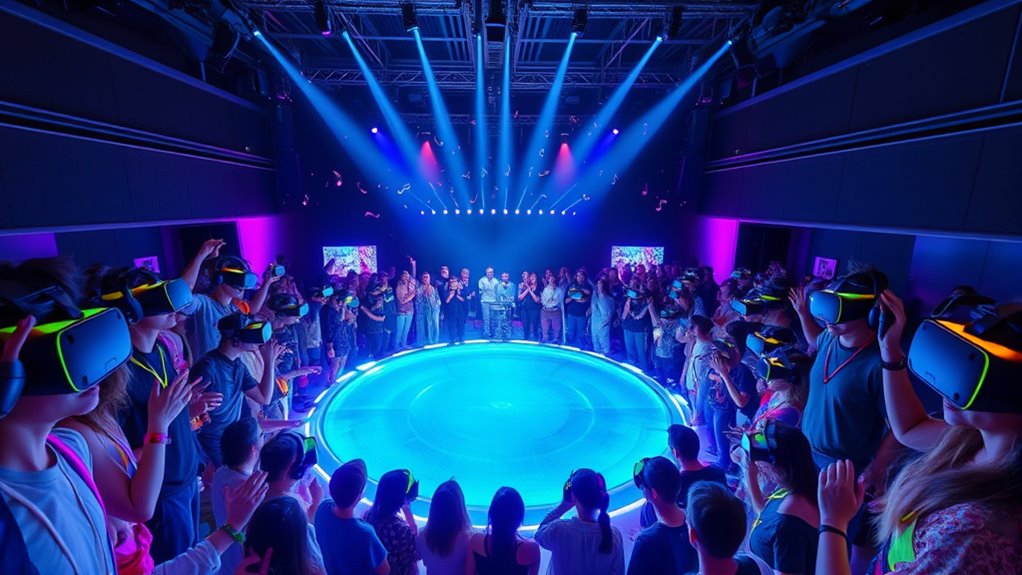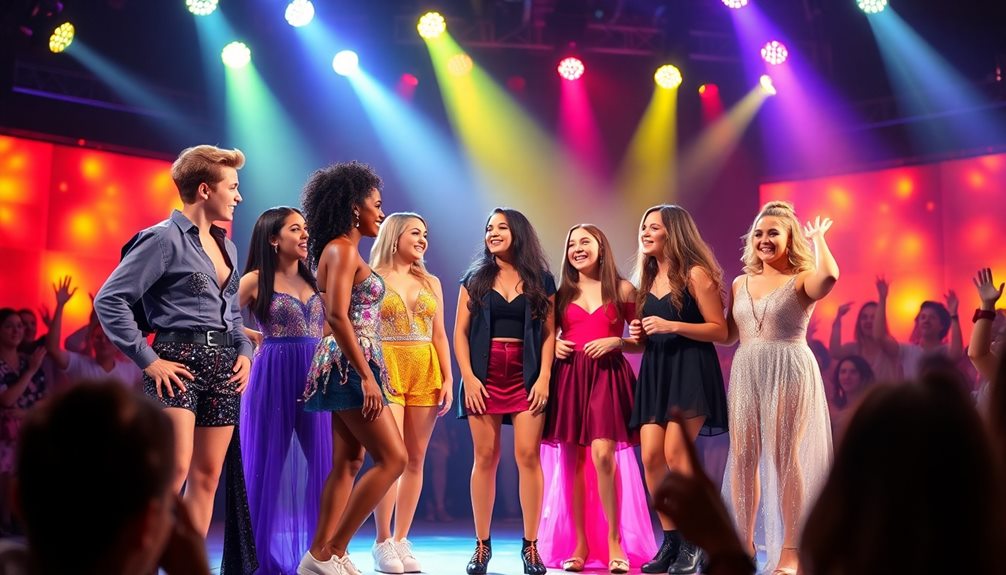Virtual concerts are changing how you experience live music, using advanced technology like AR to bring immersive visuals and interaction to your home or anywhere you are. While these online events make concerts more accessible and engaging, they aren’t likely to fully replace traditional venues anytime soon. Physical spaces offer a unique communal energy and atmosphere that virtual shows can’t completely replicate. To discover how these trends are evolving and what the future might hold, keep exploring the details ahead.
Key Takeaways
- Virtual concerts enhance accessibility and engagement but lack the physical atmosphere of traditional venues.
- AR technology creates immersive experiences, but cannot fully replicate live crowd energy and ambiance.
- Physical venues offer unique social interactions and shared energy, difficult to duplicate virtually.
- Hybrid events combining virtual and in-person elements are emerging, suggesting venues will evolve rather than become obsolete.
- Challenges like ticket scalping and digital fatigue may influence the balance between virtual and physical concert experiences.

Virtual concerts have surged in popularity, especially as technology makes remote experiences more immersive and accessible. With advancements like Augmented Reality (AR), you can now feel as if you’re right there on stage, even from thousands of miles away. AR overlays digital visuals onto your real-world environment, enhancing the sense of presence and making the concert experience more engaging. Imagine wearing AR glasses that project the artist directly into your living room, allowing you to interact with virtual elements or even see special effects unfold around you. This level of immersion blurs the line between physical and digital, making traditional concert venues seem less essential. Additionally, virtual concerts can provide enhanced user engagement through interactive features, creating a more personalized experience for each attendee. However, as virtual concerts become more sophisticated, they also introduce new challenges. Ticket scalping remains a persistent issue, even in the digital domain. Instead of buying tickets from a venue box office, you might find that tickets are quickly snatched up by resellers who inflate prices, making genuine fans pay a premium just to secure access. This problem isn’t new; it’s been a thorn in the side of concert organizers for years. But in the virtual space, scalpers can operate even more efficiently, using bots to buy large quantities of tickets the moment they go on sale. While some platforms implement measures like dynamic pricing or anti-bot technology, scalping still threatens to undermine the accessibility and fairness of virtual events. The convenience of attending concerts from anywhere could eventually diminish the need for physical venues, but it’s unlikely they’ll vanish entirely. Venues offer a communal experience that’s hard to replicate online—clapping along with thousands of other fans, the energy of a packed crowd, and the tangible atmosphere of a live event. Still, virtual concerts can complement this experience, especially for fans who can’t travel or afford ticket prices. They democratize access, allowing more people to enjoy live music in ways that weren’t possible before. In the end, the rise of virtual concerts won’t necessarily make venues obsolete but will reshape how we enjoy live music. You may find yourself attending a hybrid event, combining the best of both worlds—immersive AR experiences from your home and the vibrant community of a physical venue. As technology continues to evolve, so will the ways you connect with artists and fellow fans, making live music more inclusive and innovative than ever. Just keep in mind that issues like ticket scalping will need ongoing solutions to ensure everyone can enjoy these digital front-row seats.
Frequently Asked Questions
How Do Virtual Concerts Impact Local Economies?
Virtual concerts substantially impact your local economy by shifting spending from physical venues to digital platforms. You might see less foot traffic at local businesses like restaurants and shops, which rely on concertgoers. As the digital economy grows, your community could experience a decline in revenue from traditional events, making it harder for local businesses to thrive. This change challenges the sustainability of physical venues and alters how your economy functions.
Will Virtual Concerts Replace All In-Person Events?
Imagine a river flowing, sometimes rushing, sometimes calm; virtual concerts are like that. You might think they’ll replace all in-person events, but audience engagement thrives in the tangible world, where face-to-face connections matter. Technological limitations can create rapids and obstacles, preventing a full replacement. So, while virtual concerts grow, they won’t entirely replace in-person experiences, which still offer a unique, irreplaceable flow of human connection.
What Are the Environmental Benefits of Virtual Concerts?
Virtual concerts considerably reduce your carbon footprint by cutting down on travel and transportation emissions. They also lower energy consumption compared to traditional venues that require lighting, heating, and cooling. By choosing virtual events, you help decrease environmental impact, making concerts more sustainable. You’ll enjoy live music without contributing to pollution or resource depletion, making virtual concerts a smarter, eco-friendly alternative that benefits both you and the planet.
How Do Artists Monetize Virtual Performances Effectively?
Imagine virtual performances as a digital stage where you hold the spotlight. To monetize effectively, you should boost ticket sales by offering tiered access, exclusive content, or behind-the-scenes perks. Engaging fans through live chats, Q&A sessions, and interactive elements transforms viewers into loyal followers. When you create an immersive experience, your virtual concerts become a treasure trove, turning virtual applause into real revenue.
Can Virtual Concerts Offer the Same Social Experience as Live Venues?
You might wonder if virtual concerts can match the social vibe of live venues. While they excel in technological accessibility, offering global audience engagement, they often lack the physical presence and spontaneous energy of in-person events. However, interactive features like chat and virtual meet-and-greets help bridge the gap. Ultimately, virtual concerts provide a unique social experience, but they may not fully replace the atmosphere of traditional venues.
Conclusion
As you step into the future, virtual concerts are like open windows—offering boundless views without walls. While traditional venues may fade into memories, they still symbolize the heartbeat of live music, a reminder of shared human connection. You’re invited to embrace this new era, where technology becomes the bridge, and the stage is anywhere you choose. The choice is yours: hold onto familiar walls or dance freely in the limitless sky of virtual sound.










